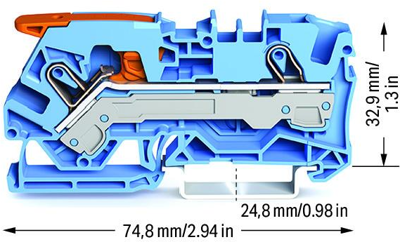Through terminal block, 2106-1204, WAGO
This through terminal block (item number 2106-1204) streamlines wire connections, making them both quick and easy. Whether in industrial or building applications, our rail-mount through terminal blocks are the perfect solution to quickly and securely connect electrical conductors. Depending on the model, you can use them for either typical through-wiring or potential distribution. Rated current and voltage are key factors to consider when selecting a through rail-mount terminal block, as they indicate how the product can be used. This product has a rated voltage of 800 V and a rated current of 41 A. Conductors can only be connected to this through terminal block if their strip length is between 13 mm and 15 mm. Featuring conductor terminals along with Push-in CAGE CLAMP, this connector delivers reliable performance. Our Push-in CAGE CLAMP is a universal, maintenance-free connection solution for all conductor types, boasting a key feature: It allows direct insertion of both solid and fine-stranded conductors with ferrules without needing tools. No preparation is required, for example, crimping the conductor's ferrule is not necessary. The dimensions are 7.5 x 74.8 x 39.5 mm (width x height x depth).
Depending on the conductor type, this through terminal block is suitable for conductor cross sections ranging from 0.5 mm² to 10 mm². It comes with one level and two clamping points for connecting a single potential. The blue housing is made of polyamide (PA66) for insulation. This through rail-mount terminal block is operated with lever,operating tool. Our TOPJOB S rail-mount terminal blocks guarantee reliable electrical connections in various industrial applications and modern building installations. They simplify wiring, as you can quickly plug in solid, stranded, and fine-stranded conductors with ferrules. These through rail-mount terminal blocks are mounted using DIN-35 rails. The front-entry wiring makes it possible to connect copper conductors. The two jumper slots enable potential distribution to other clamping points.


